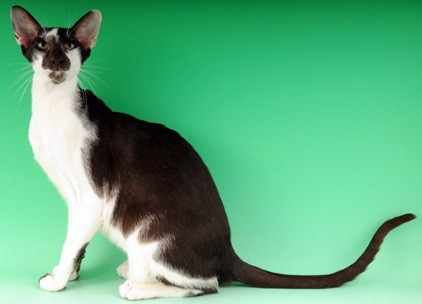Type the name of the breed you're looking for below
[wpdreams_ajaxsearchlite] Don't see the breed your're looking for? Click here and let us know!
Breed Characteristics
1 paw - breed exhibits the least amount of this characteristic
5 paws - breed exhibits most amount of this characteristic
Oriental Bicolour
| Origin And History | Although some experimental breeding took place during the 1970s and 1980s in the UK, including Pat Turner's Seychellois breeding program, the modern-day Oriental Bicolour owes its origins to mating's initiated in the USA by Lindajean Grillo (Ciara Cattery). Starting in 1979, Grillo carried out a series of mating's between Siamese and Bicolour American Shorthair. She then selected the best Bicolour offspring to mate back to Siamese or Orientals in order to regain type. The variety was granted recognition by TICA in 1983 and the first champion was Ciara Quite-N-Oreo. During the 1980s European breeders, principally those in France and the Netherlands, initiated their own Oriental Bicolour breeding lines. A red and white female Moroccan street cat was used as an initial outcross, then later on a Black & White Cornish Rex. Further cats were imported from the USA. It was important for breeders to have different lines in order to be able to mate bicolour to bicolour and obtain a higher proportion of white on the coat, without excessive inbreeding. FIFe granted championship recognition in 2003 to the Bicolour Oriental Shorthairs and in 2005 to the colourpoint and white cats under the breed name Seychellois. Although there was a small breeding program stemming from the last of Pat Turner's cats being kept by the late Barbara Lambert(Nomis cattery, breeding under FIFe guidelines), this disappeared following her death in the early 2000s. The first modern-day Oriental Bicolours were imported to the UK starting in 2004 with the arrival of Black & White male Tassam Tom of Landican owned by Sarah Johnson and Pat Norman of the Landican Cattery. The variety gained official Preliminary recognition with the GCCF in 2006. In 2008 the breed progressed to Provisional Status, the fastest breed recognition within this organisation and a mark of the breed's popularity and success. |
| Personality | Oriental Bicolour Cat breeds adapt immediately to their new environment. They have no physical or emotional when moving into a new home. This cat breed requires no time to make new human friends. It will easily warm up to them after a brief introduction. The Oriental Bicolour Cat breed can be very social, but does not require a lot of interaction. They are a great pet for owners that are looking to spend occasional time with their cats. This cat is good for homes with children. It does a good job tolerating their unfledged behavior. The Oriental Bicolour Cat is perfect for owners who already have a dog or two. This cat gets along very well with canines. This cat enjoys being loving. Owners can expect this cat to snuggle up with them after a long day out. While many cat breeds are playful, the Oriental Bicolour Cat is not. This breed is not the choice for those who are looking for a playful family cat. While young, the Oriental Bicolour Cat breed shows a playful demeanor, but soon outgrows it as it ages. This cat will often play when interacted with, but does not seek out the playful interaction on its own. The Oriental Bicolour Cat breed is quite playful. Owners should have a stash of fun cat toys available for this cat breed. This cat breed loves to play so much that it will often wake its owner up, at the start of each day, for playtime. This cat has a little more energy than other breeds, which makes it more active. Not many cats are as smart as this one. The Oriental Bicolour Cat is one of the most intelligent cats in the world. |
Physical Attributes
| Appearance | The Oriental Bicolour is a cat of Oriental type with a long, slender body and tapering whip-like tail. The triangular shape of the head is made of straight lines with a straight side profile and large, wide-set ears. The eyes are green, except in the colourpoint varieties which have blue eyes. The coat on the shorthaired variety is sleek, close-lying and glossy, while that of the longhair is fine and silky, lying flat to the body with no thick undercoat and forming a plume on the tail. The full range of colours seen in Siamese and Orientals is permitted, however a defining feature of breed is that they always have white spotting. In a cat of show quality this should extend to cover at least one third of the body and the distribution may be random and quirky like splashed paint. There is always a greater distribution of white on the cat's underside and legs in comparison with its back. This patterning is caused by the dominant white spotting gene, which is symbolized with the letter S. |
| Health | Owners have stated that this cat is prone to health problems. This is a cat breed that requires extra attention as it gets older. As with all pets, owners should expect health problems to occur as the pet gets older. Common health problems for the Oriental Bicolour Cat breed are Diarrhea, Feline Lower Urinary Tract Disease, and Eye Problems. The Oriental Bicolour Cat breed is hypoallergenic and, in most cases, will not cause a reaction in those who have cat allergies. |



